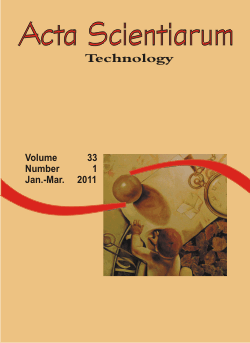<b>Development of an electronic manual penetrometer</b> - doi: 10.4025/actascitechnol.v33i1.5914
DOI:
https://doi.org/10.4025/actascitechnol.v33i1.5914Keywords:
Compaction, mechanical resistance of soil to compaction, data acquisition systemAbstract
Excess machine traffic can cause compaction that is harmful for crop growth. One way to obtain evidence of soil compaction is to check the mechanical resistance of soil. Thus, an electronic penetrometer was developed according to ASAE (1998) Standard S313.2, featuring a 9.53 mm wide diving shaft and a 30° circular stainless steel cone with a 12.83 mm base diameter. The penetrometer was outfitted with a data acquisition system, distance and force sensors, and stainless steel circular bars to construct the diving shaft and cone. The device stores field data collected at a frequency of 4 Hz, which are later transferred onto a microcomputer via a RS232 interface. The collected data can be processed using an electronic spreadsheet according to user needs. The sensors proved reliable during use, and the data files produced by the device provided comfort and confidence during data processing, so that the data could be reorganized according to user needs, thus avoid reading mistakes through the visual process.Downloads
Download data is not yet available.
Downloads
Additional Files
Published
2011-02-04
How to Cite
Tieppo, R. C., Gabriel Filho, A., Silva, S. de L., & Gnoatto, E. (2011). <b>Development of an electronic manual penetrometer</b> - doi: 10.4025/actascitechnol.v33i1.5914. Acta Scientiarum. Technology, 33(1), 9–15. https://doi.org/10.4025/actascitechnol.v33i1.5914
Issue
Section
Agricultural Engineering
License
DECLARATION OF ORIGINALITY AND COPYRIGHTS
I Declare that current article is original and has not been submitted for publication, in part or in whole, to any other national or international journal.
The copyrights belong exclusively to the authors. Published content is licensed under Creative Commons Attribution 4.0 (CC BY 4.0) guidelines, which allows sharing (copy and distribution of the material in any medium or format) and adaptation (remix, transform, and build upon the material) for any purpose, even commercially, under the terms of attribution.
Read this link for further information on how to use CC BY 4.0 properly.











8.png)




